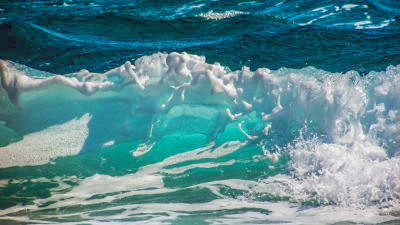← students

| First name: | Clelia |
| Last name: | Donà |
| Country: | Italy |

Thesis Subject:Metabolism of biogenic sulfur in phototrophic bacteria - enzymology and molecular biology.
| Education: | |
| Since Sept. 2006 PhD student in the International Max Planck Research School of Marine Microbiology. | |
| Dec. 2005 University Degree in Biology (Laurea) at the University of Trieste, Italy. |
Scientific Interests and Goals:Reduced inorganic sulfur compounds are concentrated sources of electrons at a low redox potential and can be biologically oxidized by prokaryotes. Sulfur occurs in -2 to + 6 oxidation state, so sulfide can donate 8 electrons if oxidized to sulfate. These electrons can be used by aerobic chemotrophs (belonging to Archaea or to Bacteria domain) and by anaerobic phototrophic bacteria to gain energy or for carbon dioxide fixation. The oxidation of reduced sulfur compounds can lead to the production of elemental sulfur globules as intermediate or final product.
Phototrophic sulfur bacteria can occur where the photic and the anoxic zones overlap. The group of purple sulfur bacteria comprises the families Chromatiaceae and Ectothiorhodospiraceae, both belonging to γ-Proteobacteria and grouped together within the order Chromatiales. Both of them can grow photolithoautotrophically using reduced inorganic sulfur compounds as electron donors and both form “sulfur globules” as intermediate or final sulfur component which is deposited inside (Chromatiaceae) or outside (Ectothiorhodospiraceae) the cells. A particularly well studied representative of the Chromatiaceae is Allochromatium vinosum, in which the intracellular sulfur globules are surrounded by a protein layer.
Green sulfur bacteria (Chlorobiaceae) are obligate photolithotrophs with limited ecological flexibility and in stratified environments they can be found under a layer of purple sulfur bacteria. They tolerate high sulfide concentrations and low light intensities. Phylogenetically, they are a coherent and isolate group, whose distinct cytological feature is the presence of chlorosomes. Elemental sulfur produced during oxidation of sulfide is deposited outside their cells.
My research will address to reveal detailed aspects concerning the uptake and usage of “commercial” (S0) and “biogenic” (bioS0) sulfur. Both are insoluble in water. The cellular mechanism of activation and uptake of elemental sulfur is not very well understood: my task will be to reveal the mobilization of S0 and bioS0 on enzymatic and molecular basis in green sulfur bacteria.
Phototrophic sulfur bacteria can occur where the photic and the anoxic zones overlap. The group of purple sulfur bacteria comprises the families Chromatiaceae and Ectothiorhodospiraceae, both belonging to γ-Proteobacteria and grouped together within the order Chromatiales. Both of them can grow photolithoautotrophically using reduced inorganic sulfur compounds as electron donors and both form “sulfur globules” as intermediate or final sulfur component which is deposited inside (Chromatiaceae) or outside (Ectothiorhodospiraceae) the cells. A particularly well studied representative of the Chromatiaceae is Allochromatium vinosum, in which the intracellular sulfur globules are surrounded by a protein layer.
Green sulfur bacteria (Chlorobiaceae) are obligate photolithotrophs with limited ecological flexibility and in stratified environments they can be found under a layer of purple sulfur bacteria. They tolerate high sulfide concentrations and low light intensities. Phylogenetically, they are a coherent and isolate group, whose distinct cytological feature is the presence of chlorosomes. Elemental sulfur produced during oxidation of sulfide is deposited outside their cells.
My research will address to reveal detailed aspects concerning the uptake and usage of “commercial” (S0) and “biogenic” (bioS0) sulfur. Both are insoluble in water. The cellular mechanism of activation and uptake of elemental sulfur is not very well understood: my task will be to reveal the mobilization of S0 and bioS0 on enzymatic and molecular basis in green sulfur bacteria.


